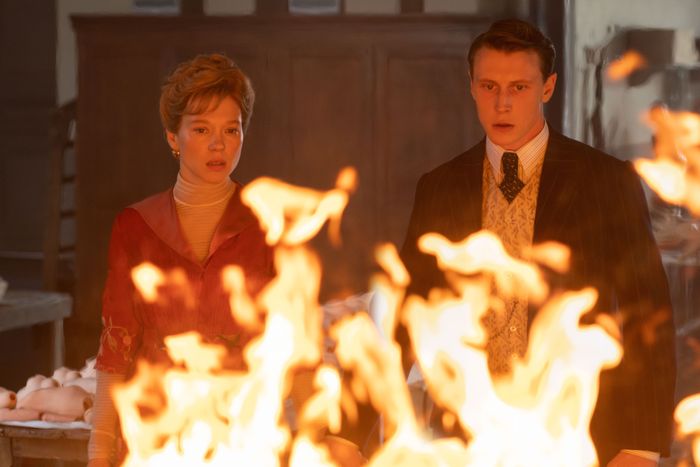
Léa Seydoux and George MacKay play thwarted lovers over three different lifetimes in The Beast, but I wouldn’t describe Bertrand Bonello’s unsettling feature as a romance. It tries out different genres, from period drama to science fiction, but it’s closest in spirit to a horror movie. This is acknowledged by the opening scene, in which Seydoux steps out onto a green-screen set to enact being threatened by a monster that will be added in post. An off-screen voice guides her through the blocking and directs her to her mark. Can she pretend to be afraid of something that isn’t there? She can, and she does, producing a show of animal panic as an ominous score strikes up and the camera closes in to capture her wild eyes. The power of her fear makes it an eerie sight, even knowing there’s no actual threat — an idea that The Beast echoes and remixes as it leaps from period to period and mode to mode, flinging its characters together in different doomed scenarios.
Seydoux’s character, Gabrielle, is a model and aspiring actor in 2014 Los Angeles, which explains the green screen — she’ll later book a gig on a similar set to shoot a grotesque safety video in which she’s flung around on wires in a simulation of a car accident. In Paris in 1910, Gabrielle is the aristocratic wife of a doll-factory owner, while in the hollowed-out future of 2044, she’s a dissatisfied worker in a world dominated by AI, where professional advancement requires submitting to a procedure that rids you of strong emotions by regressing you through your past lives. That last scenario is, in theory, the film’s present day and the point from which The Beast starts. But there’s a case to be made for each timeline being the dominant one, which keeps a viewer off-balance. The earliest story line is most directly related to the film’s loosely cited source material, the 1903 Henry James novella The Beast in the Jungle, about a man who refuses to marry or allow anyone into his life because he’s convinced that some unspecified doom is coming his way. For me, though, the 2014-set scenes exert the greatest pull, because of a daredevil bold choice: They draw inspiration from a real, and recent, mass shooter.
In each of the entwined segments, Gabrielle encounters MacKay’s character, Louis, and is inexorably drawn to him despite it always leading to her destruction. In 1910, he’s an Englishman she reencounters at a party after meeting him at a dinner years before, and in 2044, he’s another candidate questioning whether the “purification” process is right for him. But in 2014, he’s an incel with violent intentions who stalks Gabrielle back to the sprawling place where she’s house-sitting, representing a direct threat to her life rather than one to her stability or to her heart. The paralyzing fear in James’s book becomes a specifically masculine one in the movie — a fear of vulnerability and getting hurt. In flooded Paris, Louis pursues the now happily married Gabrielle, having been too intimidated to express interest in her when they first met. In the future, where everyone wears gas masks to walk through city streets so desolate that wildlife freely roams, Louis looks like a fellow holdout against the numbing bargain offered by AI but can’t be relied upon to hold strong.
In 2014, he’s channeled his apprehension about rejection into rage, which he expresses in misogynistic video rants that draw from Elliot Rodger. When Gabrielle approaches Louis in the wake of an earthquake that brings everyone outdoors, he’s stiff and unreceptive to her advances, unwilling to accept that she might genuinely be interested. This Louis is significantly more extreme than the others, and The Beast flounders a bit in trying to link the fears holding all three back. But that’s also what’s so engaging about the movie — it overflows with intriguing ideas, even if they aren’t all fully explored. Different elements recur like rhymes: The doll factory in 1910 is mirrored by an animatronic toy that keeps Gabrielle company in 2014 and by the gynoid, played memorably by Saint Omer’s Guslagie Malanda, assigned to watch over her in 2044. Gabrielle is rejected by a trio of women at a Hollywood Boulevard nightclub in Los Angeles, only for the exact same encounter to happen at a retro disco in the future. There are repeat run-ins with clairvoyants, bodies floating in water, and admiring touches of hands. Throughout all this, Seydoux, an absurdly watchable actor who came close to stealing last month’s Dune: Part Two with only a handful of scenes, shifts seamlessly between corseted melodrama and dystopian sci-fi.
Still, it’s in the period closest to the present day where she’s most impressive. Bonello cribs heavily from David Lynch for the 2014 segment, which is suffused with dreamlike dread as the lonely Gabrielle haunts dance spots and drifts around the fish tank of a mansion she’s been living in, her desire for human connection overcoming her sense of self-preservation. It’s difficult to make a character feel tangible and human while also allowing them to do inexplicable things. But even when Gabrielle is in the grip of forces she seems hopeless to control, Seydoux finds warmth and a kamikaze openness that allows room for hope even amid several existences’ worth of pain. Better to be contradictory and messy and feel too much than to be dully consistent — praise that also applies to The Beast as a whole.
More Movie Reviews
- The Thriller Drop Is a Perfect Addition to the Bad-First-Date Canon
- The Accountant 2 Can Not Be Taken Seriously
- Another Simple Favor Is So Fun, Until It Gets So Dumb


